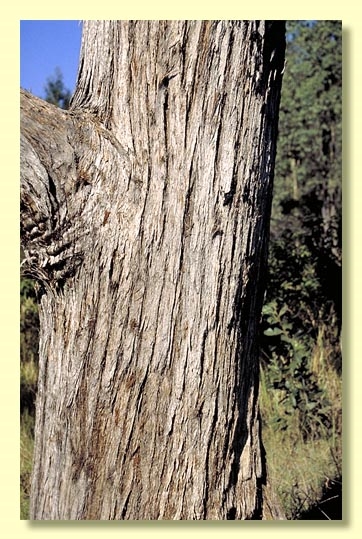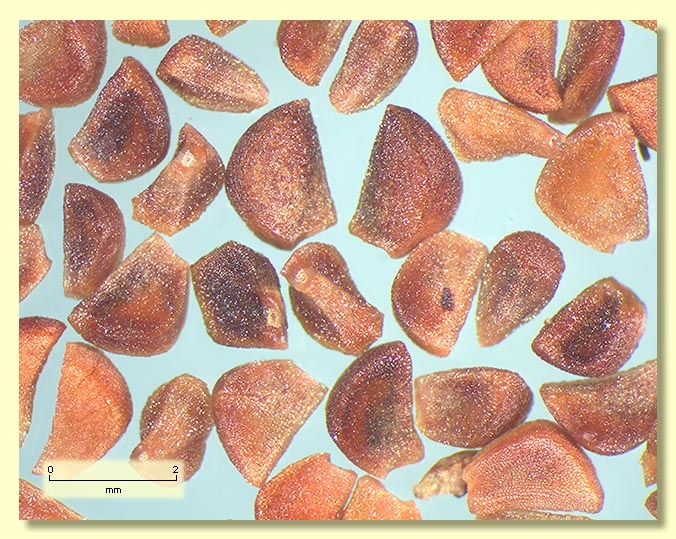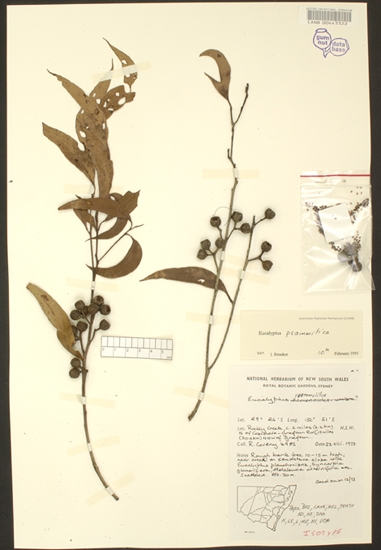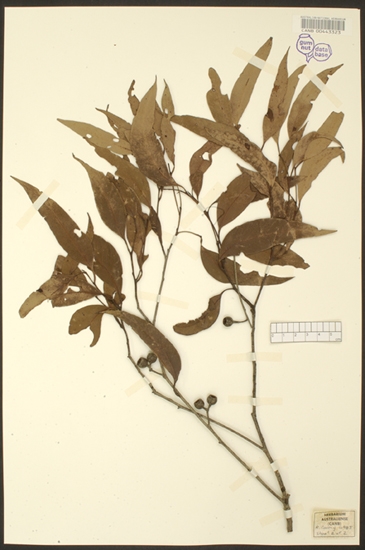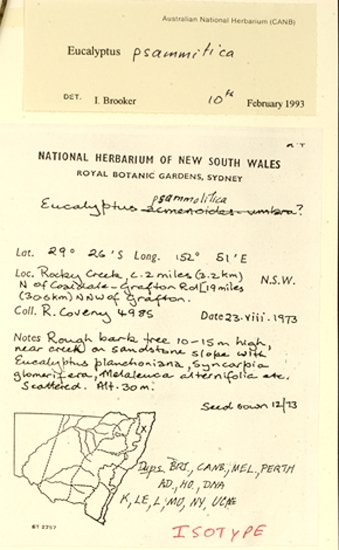Euclid - Online edition
Eucalyptus psammitica
Eucalyptus | Eucalyptus | Amentum
Bark rough, stringy or fibrous, loose, prickly, not furrowed, grey or grey-brown.
Juvenile growth (coppice or field seedlings to 50 cm): poorly known; juvenile stem rounded in cross-section; juvenile leaves sessile and opposite for some nodes (?until at least 50 cm tall), ovate, to 6.5–11 cm long, 2–5 cm wide, base rounded, green, discolorous.
Adult leaves alternate, petiole 1–2 cm long; blade lanceolate to falcate, 7–18 cm long, 1.2–3 cm wide, base tapering to petiole, concolorous or slightly discolorous, glossy, green, side-veins greater than 45° to midrib, moderately to densely reticulate, intramarginal vein parallel to and remote from margin, oil glands island or obscure.
Inflorescence axillary unbranched, peduncles 0.5–1.8 cm long, buds 7 to ?15, pedicels 0.3–0.7 cm long. Mature buds ovoid (0.6–0.7 cm long, 0.3–0.5 cm wide), green to yellow, scar absent, operculum conical to beaked, stamens irregularly flexed, anthers reniform to cordate, versatile, dorsifixed, dehiscing by confluent slits, style long, stigma tapered, locules 3 or 4, the placentae each with 2 vertical ovule rows. Flowers white.
Fruit on pedicels 0.3–0.7 cm long, cup-shaped to hemispherical, 0.7–0.9 cm long, 0.8–0.9 cm wide, disc level, valves 3 or 4, near rim level or enclosed.
Seeds brown, 1–2 mm long, pyramidal or obliquely pyramidal, dorsal surface usually smooth, hilum terminal.
Cultivated seedlings (measured at ca node 10): seedlings incompletely known. Cotyledons reniform; stems rounded in cross-section; leaves sessile, opposite for ca 10 nodes, lanceolate with base amplexicaul, to ca 8 cm long, ca 3 cm wide, margin entire, discolorous, glossy, green.
Flowering has been recorded in October and November.
A small to medium-sized tree restricted to subcoastal, sandstone country with shallow sandy soil, from north-west of Coffs Harbour to north-west of Grafton in north-eastern New South Wales and also south-west of Brisbane, Queensland. Eucalyptus psammitica is distinguished by its rough bark, glossy green crown of concolorous or slightly discolorous leaves, opposite lanceolate juvenile leaves, ovoid, often beaked buds and hemispherical to truncate-globose fruit that are flat-topped and more or less as long as wide.
Within its natural range the bark type of E. psammitica will distinguish it from all other eucalypt species except species of stringybark, and other white mahogany species.
All species of stringybark have adult leaves with sparsely reticulate venation and a quick inspection of fresh adult leaves against strong sunlight will be informative (venation moderately to densely reticulate in white mahoganies). In addition stringybarks have furrowed bark with much longer "stringy" fibres, thicker-walled fruit with prominent disc and juvenile leaves that are scabrid/hairy at the lower nodes at least.
Within or adjacent to the natural range of Eucalyptus psammitica are four other species of white mahogany, viz. E. acmenoides, a species of wetter forests having strongly discolorous adult leaves and fruit with a thin rim and usually a concealed or descending disc; E. carnea, a species of drier sandy sites which has shorter fruit than E. psammitica and much broader juvenile leaves that become alternate quite early during coppice growth; E. apothalassica, which has a more inland distribution and smaller fruit usually with a descending or concealed disc; and the restricted Queensland endemic E. helidonica, which has dull green adult leaves that are discolorous and juvenile leaves that are linear-lanceolate, opposite and stem-clasping for 2 m or more of coppice or sapling growth.


